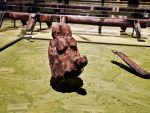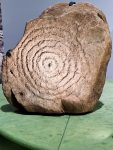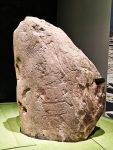
Swrily Rocks
Typical patterns
Thanks to the strange world which Covid created, it’s been a few year’s since the last visit to the always wonderful British Museum so Heather and I were pleased to find ourselves back there, for not one but two exhibitions (as well as the usual mooch around).
We arrived pretty much as the museum opened and had to stand in the queue snaking down the road from the main gates. That moved reasonably quickly but we were thankful that having paid tickets allowed us to jump half of it and get in that little bit quicker. After a quick moment of orientation we were off to the first major exhibition of the day, a look at The World Of Stonehenge.
An Ancient World

Chop Chop
Axes of history
Obviously a Stonehenge exhibition is hampered by the fact it can’t contain the star of the show, which is a bit tricky and controversial to move. The curators therefore took the approach of trying to set Stonehenge in the context of the world around it at the time it was being built and altered. So we were greeted by a huge wall of stone axe heads spanning centuries and countries, a range of early tools and strange sculptures. In keeping with the idea of Stonehenge were some intricately carved rocks, striations and patterns carved carefully, or swirls and holes. All mysterious now but presumably meaningful to the carver.

Chalk Drums
Offerings for lost children
There were stone carved objects too—notably a bowl, and a whole range of intricately carved balls which put one in mind of apprentice pieces. Probably most striking were the chalk drums found as grave goods with children. I’d seen pictures but they were smaller than I’d realised, and touching, a gift to a lost child, their meaning long forgotten but the sentiment evident still.
As one is looking at these things there is, lurking in the background, an inescapably large item. Quite surprisingly, there is a cousin of Stonehenge which can be moved—Seahenge is a timber circle which had a large, upturned tree at its centre (the central tree can’t be moved around, and was neatly represented by illuminated plexiglass of a sort). It’s a powerful draw though the spaced and incomplete circle does little to give a sense of the original layout—still at least a partial ancient monument at a temporary exhibition!

Star Of The Show
The Nebra Sky Disc
That exhibition moved on from stones to more complex objects. There were strange gold hats (looking disturbingly like sex toys) and human figures of increasing complexity and sophistication. The star though (possibly of the whole exhibition to be honest; which is a bit strange in something ostensibly about Stonehenge) was the Nebra Sky Disc. This is quite probably the oldest representation of the cosmos, mankind not only understanding but abstractly showing her knowledge. The Pleiades are clearly visible, along with crescent and full Moon. Later bands represent sunrise and sunset between solstices. It’s a fascinating little thing to stand and consider; thinking of the development of knowledge which built up in order to be able to produce such a thing.
There were a few more things, but by now we were actually slightly fatigued, the exhibition being perhaps a room or so too long. We wound our way quickly through them to the exit (and inevitable shop). While the sheer range of artefacts is fascinating the diversity somewhat detracts. It maybe the world around Stonehenge but it would have been interesting to have at least a section concentrating on closer to home, what was found, discovered, and known in the immediate surrounds and landscape of the monument. Perhaps for that one needs a pilgrimage.
A Quick Break

Seated Figure
Sexy
It had taken long enough to take in the Stonehenge exhibition that it was lunchtime by the time we emerged, so we stopped for a quick bite to eat beneath the great court roof. It’s hard to sit still for long in the British Museum though, and we couldn’t resist heading for more galleries. Seemingly we must always end up in ancient Mesopotamia, not that I’m complaining much at another chance to look at things like the Royal Game of Ur. One of my favourites would need to wait though, having been dragged to the exhibition that was coming up!
We killed time wandering the galleries, almost inevitably finding some Egyptian as well as really too many other things to recall (the only “problem” with the British Museum is it has everything). We couldn’t get too lost though for it was soon time for the second exhibition of the day.
Girl Power!

All Arms And Skulls
Kali
We’d been planning the visit to the Stonehenge exhibition for months but the second exhibition of the day was literally booked while sat in the pub about a week before. We therefore weren’t entirely sure what to expect, but it turned out to be an interesting and enjoyable collection. Themed around Feminine Power, it gave the excuse to have a diverse range of objects, ancient, old, and even modern. From goddesses (and demons), to fertility symbols, scare stories, and indeed, symbols of power, the female form has fascinated through history. Favourite pieces included a Sheela Na Gig, which have always fascinated me since I learnt of their seemingly contradictory presence on so many churches, and a ferocious, colourful statue of Kali. And of course there was the relief missing from the main galleries earlier, The Queen Of The Night standing proud in her enigmatic glory. It was all good though, from the initial wild haired woman to Athena, Venus, and the Virgin Mary. Highly enjoyable.
Stuff, Stuff, Everywhere

Snake Sculpture
Interesting way of displaying it
The day was wearing on but there was time still to have a nose around further galleries, sticking downstairs as we’d been up earlier. In search of a double headed snake used on the Museum advertising we found ourselves in the Americas galleries, which, despite our having been in the rooms leading there many times, neither of us could recall visiting before. There was some really interesting statue works, and we did find the snake—though in a display case so dark it was almost impossible to actually see.

Orrery
A nice solar system model
Talking of things we’ve probably seen but had forgotten about, we next ended up in the wildest collection of objects. The enlightenment galleries are basically Hans Sloane’s varied collections, still in traditional wooden cases with hand printed labels, a true feeling of history of the museum as well as history. The whole thing is made even more peculiar by being surrounded and interwoven glass fronted bookcases full of books (the area was originally designed to house the library of George III, and a sign still declares it to be so, but that is now in the British Library, so who knows what books they were). It was a delightful stroll through what really is a random collection, reminiscent of the stores at the NRM.
We were nearing the end of a really enjoyable visit, but Heather can’t be in the British Museum and not see the Rosetta Stone, which seems to hold a hypnotic power over her. And, of course, there had to be a wander round the museum shop before leaving for the day. Unfortunately the kitchens at the Shakespeare’s Head were closed so we could only grab a quick drink there, having to head back to the home Wetherspoons for food, and then worn out sleep.
All The Pictures

At The Museum

History Around

Marked Stone

Chop Chop

That’s A Big Dong

Bluestone

Pretty Pattern

Stone Bowl

Alien

Chalk Drums

Chalk Decorations

Swrily Rocks

Seahenge

Wooden Pillars

Close Up Of Seahenge

Target

Rainbow Rock

Hat, Apparently

Fancy Hat

Fancy Axe And Horses

Star Of The Show

Statue Apparently

Removabnle Dongs

Game Of Ur

Dinky Collection

Gnomes

Weird Guy

Cool Hat

Seated Figure

Headress

Little Fellow

Dull Faced

A Powerful Woman

Sheela Na Gig

Lilith Descends

Headress And Boobs

The Queen Of The Night

Colourful Queen

Triple Header

Just Like That

Scary Mask

Sun Face

Cat Thingy

Minerva

Nananana

All Arms And Skulls

I Will Hold You

Weird Vibe

Mary

Patience

Can You Give Me A Hand?

Golden Calm

Dum Dum

South American Statues

Grumpy

Strange

Snake Sculpture

Looks Happy

Ride That Lion

Cupid

Orrery

Ride The Elephants

Bill And Ben

Woof

Comments and Pings